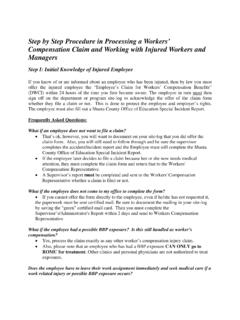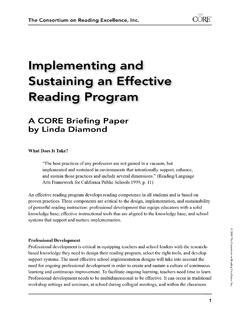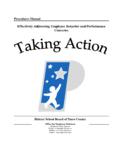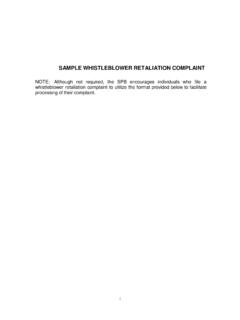Transcription of FRISK MANUAL FRISK Overview - shastacoe.org
1 FRISK MANUAL FRISK Overview FRISK Documentation Model, Practical Guidelines for Evaluators in Documenting Unsatisfactory Employee performance is designed for public sector evaluators as a communication framework to help promote positive change in substandard employee performance or to correct misconduct. It uses the primary elements of just cause to form the basis of the FRISK components. The Model reviews each of these components and their specific application as part of an assertive communication skills strategy to promote change and develop a clear understanding of performance expectations. Emphasis is placed on open, honest, and precise information sharing to avoid misinterpretation and provide employees with clear direction for change within an accountable and considerate working relationship.
2 What does FRISK stand for? FRISK is an acronym representing the universal components which should be included in any communication with employees involving performance problems or misconduct. These communication components represent the FRISK Language. Each of these components has a special purpose: F FACTS evidencing the employee s unsatisfactory conduct. R RULE or authority violated by the employee s behavior. I IMPACT of the employee s unsatisfactory conduct on the workplace. S SUGGESTIONS to assist the employee in improving performance and directions as to the proper conduct the employee is expected to follow in the future.
3 These directions are also referred to as Directives such as Immediately you . K KNOWLEDGE of the employee s right to respond to corrective documentation placed in the personnel file. The FRISK Model focuses on each FRISK communication component and identifies basic guidelines and procedures necessary for their proper application in communicating, documenting, and correcting employee performance problems. It is a critical component in a progressive discipline model. There are three elements that must be considered: 1. The process will be positive. Emphasis is placed on the potential of employees to change/improve their behavior/ performance rather than punitive measures.
4 2. The process will be corrective. Supervisors have a responsibility to assist employees in modifying their conduct. 3. The process will be progressive. By progressively increasing the severity of the communication and discipline imposed for persistent misconduct or failure to meet the established standard it is expected that employees will be given the necessary incentive to take corrective action. There are three consecutive types of communications used for correcting employee behavior/ performance : a) Counsel; the supervisor will normally use informal operational guidance techniques for performance related issues as a first response, subject always of course, to the severity of the issue.
5 If step (a) fails, the supervisor will proceed with step (b) and if that fails, step (c). b) Warnings; either verbal or written, that are specifically not disciplinary can have no adverse affect on an employee s employment. Meetings for this purpose do not require that supervisor request the mandatory attendance of a Union Representative, although an employee may still request a Union Representative in any case and such requests should be honored. When putting a written warning in an employee s file it is characterized as a, Letter of Direction . The employee is given the letter and the Union Representative, supervising Dean, VP, and the President are copied as well.
6 The tenor of the letter is constructive, not negative. Its purpose is to counsel and communicate, to identify or clarify expected behavior in performance of job duties. Letters of Direction do not make reference to further incidents being followed by further, possibly increased, discipline. Note: Since Letters of Direction are not disciplinary in nature there is no contractual obligation to remove these letters from a file. c) Discipline; which requires the mandatory presence of a Union Representative from the first point at which the employer believes that discipline may be required. Where circumstances are such that action must be taken before a meeting with a If discipline is found to be warranted, the employee will be given a letter, and a copy will go on the employees personnel file and copied to the Union Representative, supervising Dean, VP, and the President.
7 The tenor of the letter should leave no doubt in the employee s mind of the disciplinary consequences and potential future effect of the letter. The following is a non-exhaustive list of the differences between non-disciplinary, performance expecation ( , counsel and warning) letters and disciplinary letters: performance Expectations LetterDisciplinary LetterPurpose: to counsel and communicate, to identify or clarify expected behavior in performance of job duties. Purpose: to correct poor performance or undesirable behavior assumes that discipline is needed to achieve correction. Employer s Intention: helpful, supportive.
8 Examples used only as a means to clarify inappropriate or acceptable behavior. Employer s Intention: disciplinary. performance Expectations LetterDisciplinary LetterSupport is offered by way of training and/or other resources. Nature of Employee s conduct: culpable specific incidents or poor performance , or infraction of a rule, policy or standard. Should be clearly stated to be disciplinary. Develops, with employee s input, mutual goals to encourage employee s commitment to change. The employee is offered the opportunity to respond effectively to it. Focus: assumes behavior will change in future, when an employee understands what is expected and is supported in an effort to change.
9 Focus: expected behavior is identified, but consequences are attached to present and any failure to meet prescribed standards. A review period is set to give feedback on progress of change. Requires compliance with provisions of the collective bargaining agreement, such as the presence of a union representative, when discipline is imposed. A future disciplinable offence will be treated with no reference to this letter as a foundation for any progressive discipline. This letter may only be used to show that the employee was aware of the employer s requirements. Negative impact on employee s work record.
10 Part of progressive discipline further incidents of a similar nature may be followed by further, possibly increased, discipline. On the following pages are a FRISK Quick Reference Guide and FRISK document templates. For more specific and detailed information about the FRISK Model refer to the following: Andelson, S. J. (1998). FRISK Documentation Model, Practical Guidelines for Evaluators in Documenting Unsatisfactory Employee performance , 15th Edition. Atkinson, Andelson, Loya, Ruud & Romo publishers. FRISK Quick Reference Guide F - Facts: What did the employee do? Pinpoint the specific conduct and describe the conduct in complete and explicit terms.










